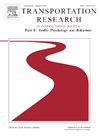Impact of multi-dimensional cognitive demands on takeover performance, physiological and eye-tracking measures in conditionally automated vehicles
IF 3.5
2区 工程技术
Q1 PSYCHOLOGY, APPLIED
Transportation Research Part F-Traffic Psychology and Behaviour
Pub Date : 2025-06-13
DOI:10.1016/j.trf.2025.06.011
引用次数: 0
Abstract
Before fully autonomous vehicles come true, drivers are still required to be responsible for driving safety and take over control of the vehicle when prompted by takeover requests in conditionally automated vehicles. Thus, drivers’ takeover performance can affect the safety of conditionally automated driving. However, though cognitive distraction can impair takeover performance in general, the influence of multi-dimensionality in the cognitive resources was under-investigated. At the same time, it is unknown how physiological and eye-tracking metrics are associated with different modalities of cognitive tasks in conditionally automated vehicles. Thus, through a driving simulation study with 42 participants, we investigated the effects of multidimensional cognitive demands, as imposed by multiple types of non-driving-related tasks, on drivers’ takeover performance, physiological responses, and eye-tracking metrics in conditionally automated vehicles. Results showed that certain takeover performance (i.e., vehicle speed and lateral acceleration), and physiological and eye-tracking metrics (i.e., differences between consecutive R-peaks, skin conductance level, variation in respiratory intervals, number of fixations, number of saccades and saccade angle) are still responsive to cognitive load in the context of driving automation. Further, the modality of the cognitive tasks can moderate the takeover performance (i.e., takeover time) and certain physiological (i.e., ratio of spectral power in the low- and high-frequency range and respiration depth) metrics. These findings suggest that, in future conditionally automated vehicles, in-vehicle task designs should consider the modality of the cognitive demands for driving safety and for the performance of the driver monitoring systems.
条件自动驾驶车辆中多维认知需求对接管行为、生理和眼动追踪的影响
在完全自动驾驶汽车成为现实之前,司机仍然需要对驾驶安全负责,并在有条件自动驾驶汽车收到接管请求时接管车辆。因此,驾驶员的接管行为会影响有条件自动驾驶的安全性。然而,尽管认知分心通常会损害接管绩效,但认知资源的多维性对接管绩效的影响尚未得到充分研究。与此同时,在条件自动驾驶汽车中,生理和眼动追踪指标与不同模式的认知任务之间的关系尚不清楚。因此,通过一项有42名参与者的驾驶模拟研究,我们研究了在条件自动驾驶汽车中,由多种非驾驶相关任务施加的多维认知需求对驾驶员接管性能、生理反应和眼动追踪指标的影响。结果表明,在自动驾驶环境下,某些接管性能(即车速和横向加速度)、生理和眼动追踪指标(即连续r峰之间的差异、皮肤电导水平、呼吸间隔变化、注视次数、扫视次数和扫视角度)仍然对认知负荷有响应。此外,认知任务的模式可以调节接管性能(即接管时间)和某些生理指标(即低频和高频频谱功率比和呼吸深度)。这些发现表明,在未来的条件自动驾驶汽车中,车内任务设计应考虑驾驶安全和驾驶员监控系统性能的认知需求模式。
本文章由计算机程序翻译,如有差异,请以英文原文为准。
求助全文
约1分钟内获得全文
求助全文
来源期刊
CiteScore
7.60
自引率
14.60%
发文量
239
审稿时长
71 days
期刊介绍:
Transportation Research Part F: Traffic Psychology and Behaviour focuses on the behavioural and psychological aspects of traffic and transport. The aim of the journal is to enhance theory development, improve the quality of empirical studies and to stimulate the application of research findings in practice. TRF provides a focus and a means of communication for the considerable amount of research activities that are now being carried out in this field. The journal provides a forum for transportation researchers, psychologists, ergonomists, engineers and policy-makers with an interest in traffic and transport psychology.

 求助内容:
求助内容: 应助结果提醒方式:
应助结果提醒方式:


